Michael J. Behe's Blog
April 13, 2023
Try 3 on a DIY ornithopter
Here, we see a third attempt:
This gives an idea of just how hard it can be to get to a Goldilocks Zone operating point, an effect of the island of function in the space of possible configurations challenge.
(One commenter noted, “I love that you are showing how much work engineering and design is. Some people don’t appreciate how many iterations it takes to make something that looks like the obvious answer.”)
In case you think this is just DIY, try this report on years of research:
Notice, ten years of effort and the fudges to get something to fly, including the augmenting mini Jet. Islands of function are all too real, even for highly intelligent designers. END
Copyright © 2023 Uncommon Descent . This Feed is for personal non-commercial use only. If you are not reading this material in your news aggregator, the site you are looking at is guilty of copyright infringement UNLESS EXPLICIT PERMISSION OTHERWISE HAS BEEN GIVEN. Please contact legal@uncommondescent.com so we can take legal action immediately.Plugin by Taragana
April 12, 2023
A Farewell and Remembrance
April 10, 2023
Bird Flight Automaton
Let’s just watch:
Notice, just the flapping, using gears and links [far simpler than the real bird]:
Amazing. END
Copyright © 2023 Uncommon Descent . This Feed is for personal non-commercial use only. If you are not reading this material in your news aggregator, the site you are looking at is guilty of copyright infringement UNLESS EXPLICIT PERMISSION OTHERWISE HAS BEEN GIVEN. Please contact legal@uncommondescent.com so we can take legal action immediately.Plugin by Taragana
Dragonfly Ornithopters
As fans of Dune will readily see, an ornithopter is a flapping wing flying machine, as a helicopter is a rotary wing flying machine. Where of course we have seen how Dragonflies are elliptical winged insects capable of up to 56 km/h speed. They also have pterostigmas that control flutter, gaining up to 25% speed [in gliding mode]. Then, there are airflow and wing flex sensors that indicate sophisticated, highly tuned control loop networks. These insects are capable of forward and reverse flight, hovering and sideways flight. They also have up to 97% success rate in predation. Such a natural model will of course inspire engineers.
So, we can see here, a Dragonfly robot ornithopter:
A clip:
[image error]Resemblance to a modern attack helicopter’s pod-boom-sensor turret design is probably only partly coincidental, as form follows function:
[image error]The Dune Ornithopters, as fantasy machines, don’t count. But, we may look:
[image error]A Dune-inspired discussion:
Design for high maneuver flight seems to have led to convergent technological evolution, a point that has come up again and again in the history of technology. END
Copyright © 2023 Uncommon Descent . This Feed is for personal non-commercial use only. If you are not reading this material in your news aggregator, the site you are looking at is guilty of copyright infringement UNLESS EXPLICIT PERMISSION OTHERWISE HAS BEEN GIVEN. Please contact legal@uncommondescent.com so we can take legal action immediately.
Plugin by Taragana
April 5, 2023
Dragon Fly Wings also have air flow and wing deformation sensors
The Dragonfly is amazing:
 Fabian et all, Cell Press, “Systematic characterization of wing mechanosensors that monitor airflow and wing deformations” April 15, 2022
Fabian et all, Cell Press, “Systematic characterization of wing mechanosensors that monitor airflow and wing deformations” April 15, 2022As Fabian et al summarise:
Animal wings deform during flight in ways that can enhance lift, facilitate flight
control, and mitigate damage. Monitoring the structural and aerodynamic state
of the wing is challenging because deformations are passive, and the flow fields
are unsteady; it requires distributed mechanosensors that respond to local
airflow and strain on the wing. Without a complete map of the sensor arrays, it
is impossible to model control strategies underpinned by them. Here, we present
the first systematic characterization of mechanosensors on the dragonfly’s wings:
morphology, distribution, and wiring. By combining a cross-species survey of
sensor distribution with quantitative neuroanatomy and a high-fidelity finite
element analysis, we show that the mechanosensors are well placed to perceive
features of the wing dynamics relevant to flight. This work describes the wing
sensory apparatus in its entirety and advances our understanding of the sensori-
motor loop that facilitates exquisite flight control in animals with highly deform-
able wings.
A video discusses and illustrates:
This, of course, continues to scream, sophisticated, fine tuned, integrated systems engineering driven design.
The Dragonfly is a sophisticated ornithopter class flying machine capable of hovering, sideways and reverse flight [comparable to helicopters], with capability as a living animal, to reproduce itself.
Just the pterostigma alone, which enables up to 25% increase in flight speed by reducing wing flutter (a problem seen by the Spitfire’s designers) is already a case in point of fine tuning and islands of function in large configuration spaces dominated by non functional gibberish and with failure modes nearby. Now, we add a sensor array driven control loop, where such loops, notoriously, require Goldilocks Zone just right tuning. Worse, the wing is highly deformable and acts in an unstable flow field. That is, the required servo control is highly sophisticated and adaptive.
The Dragonfly is a case in point of sophisticated, systems level fine tuned island of function design. A further point for why we need to declare intellectual independence. END
Copyright © 2023 Uncommon Descent . This Feed is for personal non-commercial use only. If you are not reading this material in your news aggregator, the site you are looking at is guilty of copyright infringement UNLESS EXPLICIT PERMISSION OTHERWISE HAS BEEN GIVEN. Please contact legal@uncommondescent.com so we can take legal action immediately.Plugin by Taragana
April 3, 2023
L&FP, 71: The island of function, fitness peak trap
We have been using a 3-D printer-constructor formalism, and now we can use it to see how hill climbing leads to local trapping.
Again, the core formalism:
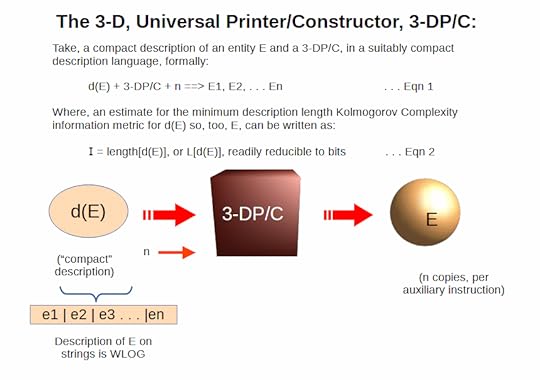
Now, let us modify by allowing some sort of local random mutation to d(E) case by case within an n-run, now seen as a generation, so E1 to En are all incrementally different, and in effect are a ring around E in a fitness landscape. From this, we can see a survival filter that on average selects for superior performance. This leads, naturally to hill-climbing, perhaps even to several related peaks in a chain on an island of function. But now, we see:
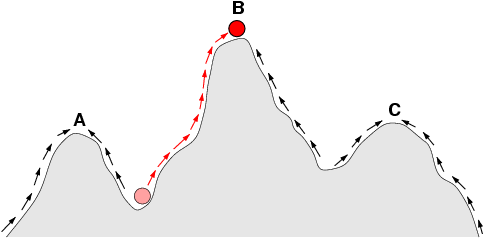 Algorithmic hill-climbing first requires a hill . . .
Algorithmic hill-climbing first requires a hill . . . Here, we see that hill climbing leads to peak trapping, as at A B or C, any change trend is downhill. Ruggedness of a fitness landscape counts, and not for the notion that hill climbing explains evolutionary advance.
No, it gets more complicated, once we realise that complex, information rich functionally specific organisation is a fine tuning phenomenon. That is, we now have the challenge of island hopping across seas of non function:
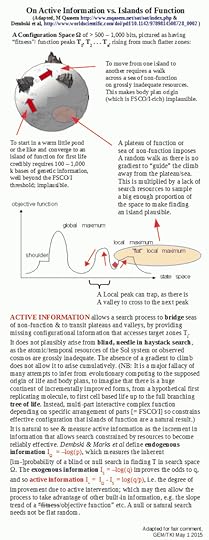
So, absent injection of active information . . . contrivance . . . there is a “natural, blind, needle in haystack search”challenge to create novel body plans. Where, if “natural selection” is acceptable, plainly so is “natural . . . search.”
This of course feeds back to getting TO the beaches of an island of function. So, we have the natural search problem in focus, once FSCO/I and fine tuned organisation are recognised.
For this, there has been much distraction and dismissiveness over the years [often, pretending hyperskeptically that FSCO/I is ill conceived], but no cogent answer, nor is there any good reason to believe in a vast continent of incrementally accessible functional forms from a last universal unicellular common ancestral form, traversing the tree of life believed to be ancestrally formed. Indeed, this brings to the surface the systematic pattern of gaps, sudden appearances and disappearances that are the trade secret of paleontology.
So, local trapping and need to arrive at shorelines of function by blind “natural . . . search” are significant challenges. Where, intentional injection of active information by intelligently directed configuration, absent ideological imposition, is a very good explanation for, say, the subtleties of a Dragonfly’s wing, including up to 25% speed improvement from flutter-reducing stigma on the leading edge of the wing . . . as obvious a case of subtle fine tuning as one may wish for:
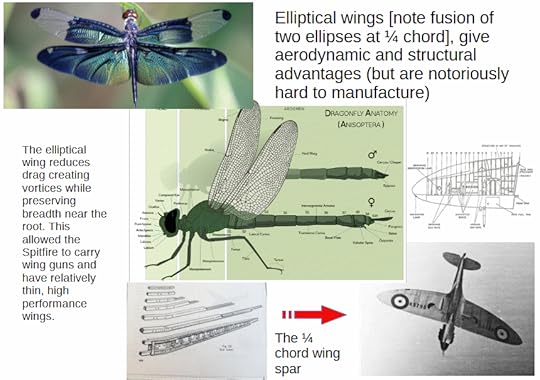
And, so forth. END
Copyright © 2023 Uncommon Descent . This Feed is for personal non-commercial use only. If you are not reading this material in your news aggregator, the site you are looking at is guilty of copyright infringement UNLESS EXPLICIT PERMISSION OTHERWISE HAS BEEN GIVEN. Please contact legal@uncommondescent.com so we can take legal action immediately.Plugin by Taragana
March 30, 2023
L&FP, 70: Exploring cosmological fine tuning using the idea of a 3-D, universal printer and constructor (also, islands of function)
Last time, we looked at how Kolmogorov Complexity can be used to quantify the information in functionally specific complex organisation, by using the formal idea of a 3-D universal printer and constructor, 3-DP/C:
. . . it is but a short step to imagine a universal constructor device which, fed a compact description in a suitable language, will construct and present the [obviously, finite] object. Let us call this the universal 3-D printer/constructor, 3-DP/C.
Thus, in principle, reduction of an organised entity to a description in a suitably compact language is formally equivalent in information terms to the object, once 3-DP/C is present as a conceptual entity. So, WLOG, reduction to compact description in a compact language d(E) is readily seen as identifying the information content of any given entity E.
For, d(E) is a program though it can simply be a functional organisational specification, as, causally in this logic-model world:
d(E) + 3-DP/C + n ==> E1, E2, . . . En.
Obviously, n is an auxiliary instruction setting the number of copies to be made . . . .
We thus have a formal framework to reduce any entity to a description d(E), which is informational and has as metric
I = length[d(E)],
where a chain of Y/N q’s will yield I in bits, on the Kolmogorov assumption of compactness. I use compact, to imply that we can get a good enough estimator of I by using something compact. We do not have to actually build a most compact language.

This can also be used to explore the idea of fine tuning, e.g. let us use Barnes; chart:
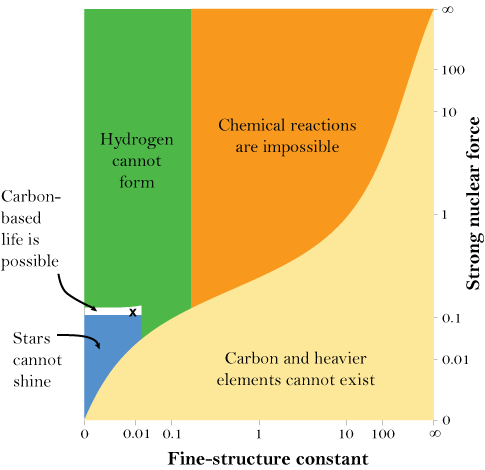 Barnes: “What if we tweaked just two of the fundamental constants? This figure shows what the universe would look like if the strength of the strong nuclear force (which holds atoms together) and the value of the fine-structure constant (which represents the strength of the electromagnetic force between elementary particles) were higher or lower than they are in this universe. The small, white sliver represents where life can use all the complexity of chemistry and the energy of stars. Within that region, the small “x” marks the spot where those constants are set in our own universe.” (HT: New Atlantis)
Barnes: “What if we tweaked just two of the fundamental constants? This figure shows what the universe would look like if the strength of the strong nuclear force (which holds atoms together) and the value of the fine-structure constant (which represents the strength of the electromagnetic force between elementary particles) were higher or lower than they are in this universe. The small, white sliver represents where life can use all the complexity of chemistry and the energy of stars. Within that region, the small “x” marks the spot where those constants are set in our own universe.” (HT: New Atlantis)Now, let us start at X, conceived as a summary of the cosmology of our observed universe, as d(E) fed into the 3-DP/C, with E here being say a simulation of the cosmos and its history:
d(E) + 3-DP/C + n ==> E1, E2, . . . En. n here would be a population of runs assuming a random element.
Now, instead, feed d(E) into a noisy channel so we begin a random walk in the space of cosmologies,
d(E) –> lossy, noisy medium –> d*(E) + 3-DP/C + 1 ==> E*1
d*(E) –> LNM –> d**(E) + 3-DP/C + 1 ==> E**1
etc.
Here, we can readily see how we can construct a map of possible outcomes, much as Barnes did and illustrates. Though of course one can also explore border zones algebraically etc.
The obvious result is that we see how our observed cosmos sits at a fine tuned operating point for a cosmos that is viable for life. (This also extends to exploring islands of function in configuration spaces in general.)
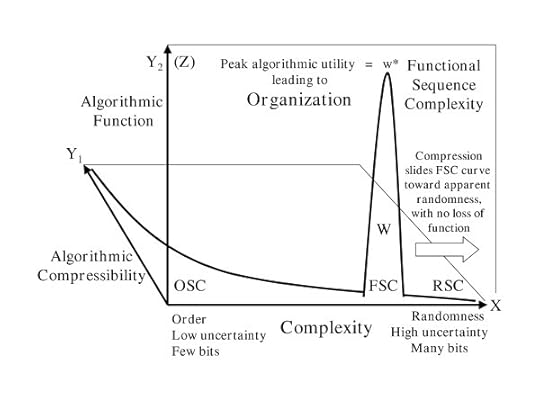
We see here how islands of function can have fitness landscapes allowing local hill climbing, but of course the issue of loss of function and locking into a peak arise:

So, now, we can use the 3-DP/C formalism to draw out what is involved in the idea of fine tuning, including of course, how intensely informational such a pattern is.
John Leslie is thought provoking:
“One striking thing about the fine tuning is that a force strength or a particle mass often appears to require accurate tuning for several reasons at once. Look at electromagnetism. Electromagnetism seems to require tuning for there to be any clear-cut distinction between matter and radiation; for stars to burn neither too fast nor too slowly for life’s requirements; for protons to be stable; for complex chemistry to be possible; for chemical changes not to be extremely sluggish; and for carbon synthesis inside stars (carbon being quite probably crucial to life). Universes all obeying the same fundamental laws could still differ in the strengths of their physical forces, as was explained earlier, and random variations in electromagnetism from universe to universe might then ensure that it took on any particular strength sooner or later. Yet how could they possibly account for the fact that the same one strength satisfied many potentially conflicting requirements, each of them a requirement for impressively accurate tuning?” [Our Place in the Cosmos, The Royal Institute of Philosophy, 1998 (courtesy Wayback Machine) Emphases added.]
AND:
“. . . the need for such explanations does not depend on any estimate of how many universes would be observer-permitting, out of the entire field of possible universes. Claiming that our universe is ‘fine tuned for observers’, we base our claim on how life’s evolution would apparently have been rendered utterly impossible by comparatively minor alterations in physical force strengths, elementary particle masses and so forth. There is no need for us to ask whether very great alterations in these affairs would have rendered it fully possible once more, let alone whether physical worlds conforming to very different laws could have been observer-permitting without being in any way fine tuned. Here it can be useful to think of a fly on a wall, surrounded by an empty region. A bullet hits the fly Two explanations suggest themselves. Perhaps many bullets are hitting the wall or perhaps a marksman fired the bullet. There is no need to ask whether distant areas of the wall, or other quite different walls, are covered with flies so that more or less any bullet striking there would have hit one. The important point is that the local area contains just the one fly.” [Emphasis his.]
This fly on the wall metaphor has been famous, and aptly captures the issue of locality of fine tuning.
 A modern watch movement, an example of both functionally specific, complex information and irreducible complexity of well-matched core functional parts
A modern watch movement, an example of both functionally specific, complex information and irreducible complexity of well-matched core functional partsWhere, too, we see that fine tuning leading to islands of function is a broad phenomenon, the bits and pieces of a complex system need to fit and work together for the whole to work.
This of course, brings us full circle to Paley’s famous watch.
Paley, in his time, could describe the intricate nature of contrivance leading to an artifact, a system well adapted to the purpose of time keeping. But, he had not the means to quantify the information involved, that would have to wait for over a century until we first found the idea of surprise and reduction of uncertainty leading to negative log probability metrics and informational entropy. Where, too, Jaynes et al were able to follow Szilard et al and draw a connexion between informational and thermodynamic entropy. In effect, the entropy of a macro observable entity is the average wanting information to specify microstate, given a description on macro observable state.
Then came Kolmogorov, and we can therefore use the formalism of a 3-DP/C to understand information content, functionality based on information implicit in organisation, and islands of fine tuned function amidst seas of non function, thus blind search challenge.
Paley, in his Ch 2, had a further contribution that has been even more underestimated. He saw that the additionality of self-replication vastly increased the complex functionality to be explained. This means that origin of life is even more complex than many acknowledge, and that origin of sustainable, novel body plans is even more challenging.
Coming back to focus, fine tuning at cosmological scale, the Nobel equivalent prize holder, Sir Fred Hoyle, has some choice words:
[Sir Fred Hoyle, In a talk at Caltech c 1981 (nb. this longstanding UD post):] From 1953 onward, Willy Fowler and I have always been intrigued by the remarkable relation of the 7.65 MeV energy level in the nucleus of 12 C to the 7.12 MeV level in 16 O. If you wanted to produce carbon and oxygen in roughly equal quantities by stellar nucleosynthesis, these are the two levels you would have to fix, and your fixing would have to be just where these levels are actually found to be. Another put-up job? . . . I am inclined to think so. A common sense interpretation of the facts suggests that a super intellect has “monkeyed” with the physics as well as the chemistry and biology, and there are no blind forces worth speaking about in nature. [F. Hoyle, Annual Review of Astronomy and Astrophysics, 20 (1982): 16.] . . .
also, in the same talk at Caltech:
The big problem in biology, as I see it, is to understand the origin of the information carried by the explicit structures of biomolecules. The issue isn’t so much the rather crude fact that a protein consists of a chain of amino acids linked together in a certain way, but that the explicit ordering of the amino acids endows the chain with remarkable properties, which other orderings wouldn’t give. The case of the enzymes is well known . . . If amino acids were linked at random, there would be a vast number of arrangements that would be useless in serving the puposes of a living cell. When you consider that a typical enzyme has a chain of perhaps 200 links and that there are 20 possibilities for each link,it’s easy to see that the number of useless arrangements is enormous, more than the number of atoms in all the galaxies visible in the largest telescopes. [ –> 20^200 = 1.6 * 10^260] This is for one enzyme, and there are upwards of 2000 of them, mainly serving very different purposes. So how did the situation get to where we find it to be? This is, as I see it, the biological problem – the information problem . . . . I was constantly plagued by the thought that the number of ways in which even a single enzyme could be wrongly constructed was greater than the number of all the atoms in the universe. So try as I would, I couldn’t convince myself that even the whole universe would be sufficient to find life by random processes – by what are called the blind forces of nature . . . . By far the simplest way to arrive at the correct sequences of amino acids in the enzymes would be by thought, not by random processes . . . . Now imagine yourself as a superintellect working through possibilities in polymer chemistry. Would you not be astonished that polymers based on the carbon atom turned out in your calculations to have the remarkable properties of the enzymes and other biomolecules? Would you not be bowled over in surprise to find that a living cell was a feasible construct? Would you not say to yourself, in whatever language supercalculating intellects use: Some supercalculating intellect must have designed the properties of the carbon atom, otherwise the chance of my finding such an atom through the blind forces of nature would be utterly minuscule. Of course you would, and if you were a sensible superintellect you would conclude that the carbon atom is a fix.
. . . and again:
I do not believe that any physicist who examined the evidence could fail to draw the inference that the laws of nuclear physics have been deliberately designed with regard to the [–> nuclear synthesis] consequences they produce within stars. [“The Universe: Past and Present Reflections.” Engineering and Science, November, 1981. pp. 8–12]>>
Food, for thought. END
Copyright © 2023 Uncommon Descent . This Feed is for personal non-commercial use only. If you are not reading this material in your news aggregator, the site you are looking at is guilty of copyright infringement UNLESS EXPLICIT PERMISSION OTHERWISE HAS BEEN GIVEN. Please contact legal@uncommondescent.com so we can take legal action immediately.Plugin by Taragana
March 29, 2023
L&FP, 69: A way to understand Functionally Specific Complex Organisation and/or associated Information [FSCO/I] i/l/o Kolmogorov-Chaitin Complexity
It seems that it is exceedingly hard for some to understand what FSCO/I is about. In responding to an objector, I wrote as follows just now, and think it is worth headlining for reference:
Where, K-Complexity is summarised by Wikipedia, as a first level point of reference that would have been immediately accessible all along:
<<In algorithmic information theory (a subfield of computer science and mathematics), the Kolmogorov complexity of an object, such as a piece of text, is the length of a shortest computer program (in a predetermined programming language) that produces the object as output. It is a measure of the computational resources needed to specify the object, and is also known as algorithmic complexity, Solomonoff–Kolmogorov–Chaitin complexity, program-size complexity, descriptive complexity, or algorithmic entropy. It is named after Andrey Kolmogorov, who first published on the subject in 1963 [1][2] and is a generalization of classical information theory.
The notion of Kolmogorov complexity can be used to state and prove impossibility results akin to Cantor’s diagonal argument, Gödel’s incompleteness theorem, and Turing’s halting problem. In particular, no program P computing a lower bound for each text’s Kolmogorov complexity can return a value essentially larger than P’s own length (see section § Chaitin’s incompleteness theorem); hence no single program can compute the exact Kolmogorov complexity for infinitely many texts.>>
From this, it is but a short step to imagine a universal constructor device which, fed a compact description in a suitable language, will construct and present the [obviously, finite] object. Let us call this the universal 3-D printer/constructor, 3-DP/C.
Thus, in principle, reduction of an organised entity to a description in a suitably compact language is formally equivalent in information terms to the object, once 3-DP/C is present as a conceptual entity. So, WLOG, reduction to compact description in a compact language d(E) is readily seen as identifying the information content of any given entity E.
For, d(E) is a program though it can simply be a functional organisational specification, as, causally in this logic-model world:
d(E) + 3-DP/C + n ==> E1, E2, . . . En.
Obviously, n is an auxiliary instruction setting the number of copies to be made.
I write ==> to imply a constructive causal process effected by a 3-DP/C.
From this we may come back to Orgel and notice his [1973] summary:
These vague idea can be made more precise by introducing the idea of information. Roughly speaking, the information content of a structure is the minimum number of instructions needed to specify the structure.
We thus have a formal framework to reduce any entity to a description d(E), which is informational and has as metric
I = length[d(E)],
where a chain of Y/N q[s will yield I in bits, on the Kolmogorov assumption of compactness. I use compact, to imply that we can get a good enough estimator of I by using something compact. We do not have to actually build a most compact language.
Then, inject random changes in d(E) and observable sensitivity to perturbation would be an index of functional specificity of organisation. As a simple case try text strings in English as d(E) and a noisy, lossy transmission medium, giving d*(E). 3-DP/C can put out text strings on d*(E) but soon enough function will vanish as d(E) becomes gibberish.
d(E) –> lossy, noisy medium –> d*(E) + 3-DP/C + 1 ==> E*1
d*(E) –> LNM –> d**(E) + 3-DP/C + 1 ==> E**1
etc.
After a few generations, gibberish predictably will destroy configuration based functional organisation, starting with text in English.
And so forth.
I trust this will help you understand what FSCO/I is about more clearly.
Now of course, 3-DP/C does not exist, though we could argue that the state of the art of technology can be seen as an early, primitive partial case. Venter et al are obviously doing engineering with life forms for example. And of course typing on a keyboard and outputting to a screen or paper are very low level examples.
Technology is not the issue, a formal representation to capture information content of a functionally organised entity is.
Conceive of say a 3-DP/C putting out worlds specified by various cosmological models. We soon enough see the point of cosmological fine tuning, e.g. see Barnes:
 Barnes: “What if we tweaked just two of the fundamental constants? This figure shows what the universe would look like if the strength of the strong nuclear force (which holds atoms together) and the value of the fine-structure constant (which represents the strength of the electromagnetic force between elementary particles) were higher or lower than they are in this universe. The small, white sliver represents where life can use all the complexity of chemistry and the energy of stars. Within that region, the small “x” marks the spot where those constants are set in our own universe.” (HT: New Atlantis)
Barnes: “What if we tweaked just two of the fundamental constants? This figure shows what the universe would look like if the strength of the strong nuclear force (which holds atoms together) and the value of the fine-structure constant (which represents the strength of the electromagnetic force between elementary particles) were higher or lower than they are in this universe. The small, white sliver represents where life can use all the complexity of chemistry and the energy of stars. Within that region, the small “x” marks the spot where those constants are set in our own universe.” (HT: New Atlantis)Similarly, contemplate the FSCO/I in an ABU 6500CT reel, using d(E) to output:

Then, let us contemplate as a related case, the von Neumann Kinematic Self Replicator:
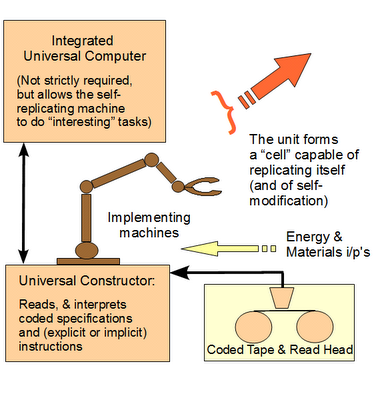 A von Neumann kinematic self-replicator
A von Neumann kinematic self-replicatorWith these in mind, now consider the configuration space, needle in haystack search challenge:
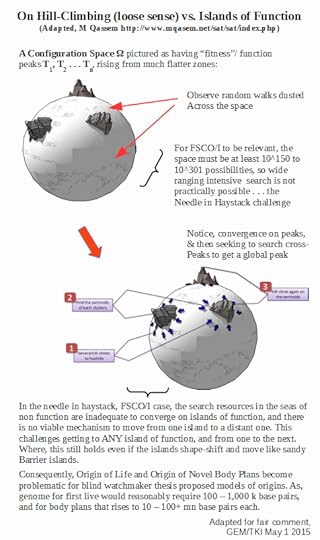
Thence, see the significance of active information:

It is thus clear that FSCO/I is a real world concept and the design inference import it carries is real, non trivial, not incoherent, and significant. END
Copyright © 2023 Uncommon Descent . This Feed is for personal non-commercial use only. If you are not reading this material in your news aggregator, the site you are looking at is guilty of copyright infringement UNLESS EXPLICIT PERMISSION OTHERWISE HAS BEEN GIVEN. Please contact legal@uncommondescent.com so we can take legal action immediately.Plugin by Taragana
March 28, 2023
L&FP, 68: Cognitive Dissonance and fallacies of projection etc
It is a sub-study of logic, to address fallacies. Accordingly, as it has come up, it seems helpful to highlight cognitive dissonance and certain associated fallacies. First, [HT: Montecinos et al, fair use] here is a recent framework for cognitive dissonance:
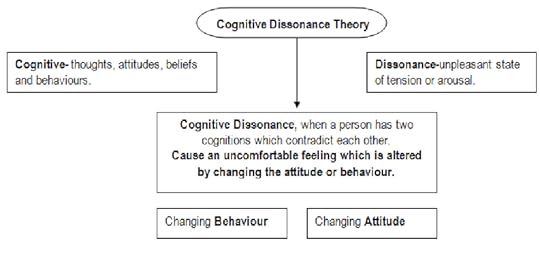
This is a simple but powerful model. As an example, it has been argued that certain free trial period software, by involving the user in considerable effort to register and use the product, then shifts attitudes towards reluctance to give up the product. Of course, many attitude, thought, belief or behaviour changes can be influenced by the need to reduce inner pain, and some of these are more justifiable in the cold light of day than others. However, some patterns of behaviour tied to cognitive dissonance are less justifiable, as has been known since ancient times.
The fable of the Fox telling itself that the bunch of grapes it cannot reach must be sour is famous, and funny. A bit more painful, is Jesus’ parable of the saw-pit where the sawyer at the top of the sawing pit is busy about the sawdust speck in the eye of the sawyer in its bottom, but manages not to realise he has a plank in his own eye.
As we turn to fallacies, a key one is projection to the other. Sometimes, confession by projection.
For example, as the descendant of such unions, I can freely point to slave masters and overseers projecting racial inferiority and many faults to black slaves . . . even as they repeatedly fathered children by slave women.
In our time, polarisation and associated acts often start with blame shifting. Mr Dawkins’ characterisation of the other as ignorant, stupid, insane or wicked, comes to mind.
A linked issue is the crooked yardstick effect. If a crooked stick is made into one’s reference standard what is actually straight, upright and accurate cannot conform to crookedness. Indeed, neither will a different form of crookedness, so getting people to swallow a crooked yardstick can become a platform for locking them into an agenda that cannot stand on its own merits.
Sometimes, these problems can become so locked in that not even a naturally straight and upright plumb line will be accepted as corrective.
Food, for thought. END
Copyright © 2023 Uncommon Descent . This Feed is for personal non-commercial use only. If you are not reading this material in your news aggregator, the site you are looking at is guilty of copyright infringement UNLESS EXPLICIT PERMISSION OTHERWISE HAS BEEN GIVEN. Please contact legal@uncommondescent.com so we can take legal action immediately.Plugin by Taragana
March 25, 2023
L&FP, 67: So-called “critical rationalism” and the blunder of denying [defeat-able] warrant for knowledge
IEP summarises:
“Critical Rationalism” is the name Karl Popper (1902-1994) gave to a modest and self-critical rationalism. He contrasted this view with “uncritical or comprehensive rationalism,” the received justificationist view that only what can be proved by reason and/or experience should be accepted. Popper argued that comprehensive rationalism cannot explain how proof is possible and that it leads to inconsistencies. Critical rationalism today is the project of extending Popper’s approach to all areas of thought and action. In each field the central task of critical rationalism is to replace allegedly justificatory methods with critical ones.
A common summary of this is that it replaces knowledge as justified, true belief, with “knowledge is unjustified untrue unbelief.” That is, we see here the ill advised privileging of hyperskepticism.
The quick answer is to update our understanding, based on how well informed people of common good sense generally use “knowledge.” Knowledge is a term of the people, not some abstruse, rarefied, dubious philosophical notion. And it is a term that is sound,
Namely, and following Plantinga, Gettier and others, knowledge is warranted, credibly true [and reliable] belief, i.e. it includes strong form cases where what is known is absolutely certain, AND a wider, weaker sense where what we claim to know is tested and found reliable, but is open to correction for cause. Newtonian dynamics counted as knowledge before the rise of modern physics and with modification to recognise limitations it still counts as knowledge. This is a paradigm case.
But doesn’t that come down to the same thing as critical rationalism and its focus on what is hard to criticise as what counts for now as “knowledge”?
Not at all.
First, the confident but open to correction spirit of warrant and tested reliability is utterly different from the cramped, distorted thought that naturally flows from the blunder of privileging selective or even global hyperskepticism.
Second, inference to the best explanation and wider observational, inductive approaches — the vast majority of common, day to day knowledge and professional practice — is not put under the chilling effect of dismissive, undue suspicion.
Third, knowledge is accepted as a commonplace phenomenon, not a privilege of the elite few, undermining the subtext of contempt that reeks out of far too much of skeptical discussion.
And if you imagine these considerations are of little weight, that is because you are part of the problem. END
Copyright © 2023 Uncommon Descent . This Feed is for personal non-commercial use only. If you are not reading this material in your news aggregator, the site you are looking at is guilty of copyright infringement UNLESS EXPLICIT PERMISSION OTHERWISE HAS BEEN GIVEN. Please contact legal@uncommondescent.com so we can take legal action immediately.Plugin by Taragana
Michael J. Behe's Blog
- Michael J. Behe's profile
- 219 followers



